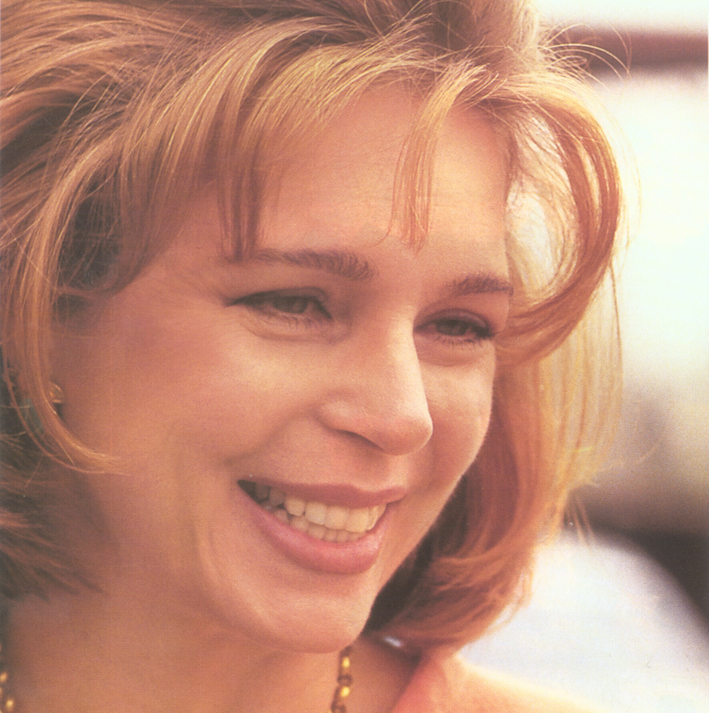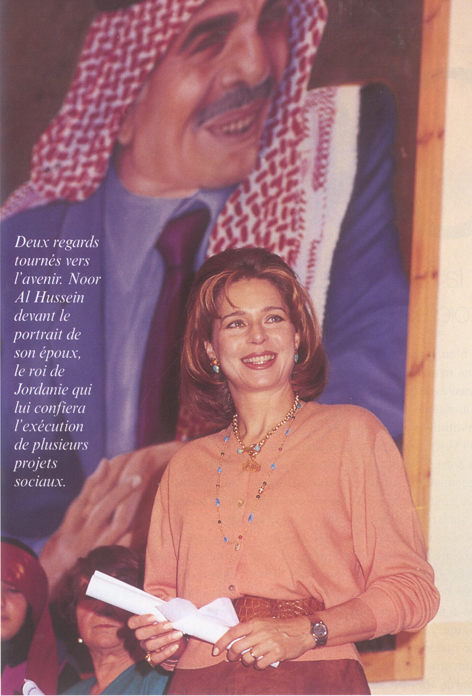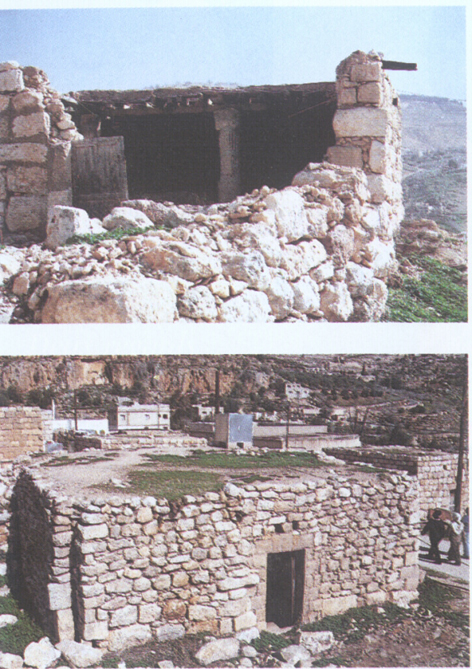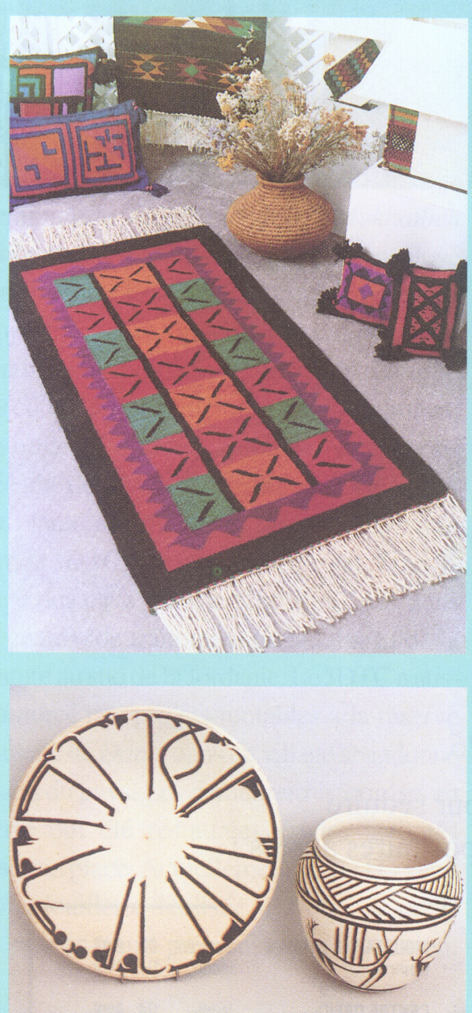Prestige issue 34, March 1996
Skillful fingers fix colors and nodes on a NAWL. Leaning on her loom, a Bedouin revives the tradition and takes one to one every thousand gestures. She suddenly looks up and raises her arms. A woman walks toward her, very beautiful, with simple majesty. It’s her! Exclamations broke out in the workshop … Noor Al Hussein! Noor: «light» who revealed Jordan’s greatest asset: its heritage.
© Prestige / Bassam Lahoud
She captivates you with the strength of her charisma. Fascinates you by the scale of her projects. Meeting with Her Majesty in Jerash.
Amman Airport. Literally a welcoming committee, two people waiting, sent by the Royal Palace of Ma’wa, a third one by the Lebanese Embassy in Jordan. A first impression of Jordan: courtesy, discretion. Outside, the lights of a city that does not sleep. Alive. With white stone houses, architectural treasures. No skyscrapers but a latent desire for immensity. The next day, the same person, taciturn and kind, leads us to our first stop: Iraq Al Amir. An archaeological reconstructed village, restored, half an hour from Amman but already deeply immersed in tradition.
We have not yet met the Queen, but her work is marked everywhere.
Inside each house, a beehive of activity and a delicious freshness. Our mentor: Awni Quandour graduate of States and director of the center. Here, we weave with happiness, the millenary production of parchment paper is recovered…
Ramadan does not slow the activity of nawls under the impetus of the gay village girls. The presence of computers seems incongruous at first, but the tradition and modernity go together well. Our meeting with Jordan’s heritage extends to Jordan Design and Trade Center (JDTC). «Our goal is to continue to create, create every day, something different.» Statement of the director Claude Zumot, also a graduate in management from the States. And the designers of the Centre do not lack ideas. Originality of modern notes intended to complement the heritage of ancestors. Mosaic patterns on multiple works, delicately aesthetic convolutions of a glass, traced vows on Salsal ceramics. We learn, with difficulty, to recognize the different bsat and call them by name because they have a name like any piece of art. From the peasants of Iraq Al Amir to Husseiniyé Bedouins, Jordan awakes to crafts, culture. Who gave the impetus? A queen so dedicated to her work that she offered us, instead of a traditional interview, to accompany her to Jerash. Historic city that has a large craft center. Departure from the Royal Palace of Ma ‘awa, on the hill of Nuzha.
At Jerash, in groups in front and inside of the Town Hall, the crowd waiting for their queen, their benefactress. It is there, fascinated, that we understand the scale of the project, the strength of her charisma, the extent of her love for Jordan, her commitment to the people that came to pay tribute to her.
Majesty, you are an architect; what is the contribution of your major in the successful implementation of your projects? I chose a major in Architecture and Urban Planning at the University of Princeton because it included several disciplines that were later a great asset to my work in Jordan. I discovered that in order to build for an individual or a community, we should understand their physical, social and spiritual needs and try to find solutions to those needs. In a sense, you can say that my major at the university helped me to become a «social architect».
«The woman can become a real economical force in her own community».
What distinguishes the Jordanian crafts from other countries? Jordanian designs reflect the richness of our history and are inspired by many ancient and contemporary cultures that flourished in Jordan. For example, the Nabataeans were famous for their fine ceramics they exported across the East. We produce Nabataean pottery style craft at the center of Salt that can be sold to tourists today.
On the other hand, the Bedouin style is very special because it produces «smooth-faced» because dense carpet; their texture is different from other styles. Our designers have also introduced for carpets and ceramic patterns inspired from mosaics. Embroidery items are typically Jordanian, eg Ma’ani point that had almost disappeared until the day the JDTC incorporated it again in its products. Another practice been forgotten and that we have revived the wheat wicker baskets woven by hand. Better, we established at Mukhaibeh a profitable project for the work of wicker wheat, palm leaves and banana …. On the other hand, the foundation provided women with new looms and spinning wheels to increase productivity. We have imposed a strict quality control from raw material to final product.
© Prestige / Bassam Lahoud
Two eyes turned towards the future. Nour Al Hussein before the portrait of her husband, the King of Jordan who entrusted her the implementation of several social projects.
What are the main lines of craft projects? I would mainly say weaving and embroidery and ceramics, gems and paper.
Is there a contribution of the younger generation of the royal family to the revival of heritage? Several young members of the family support national programs for the preservation and promotion of the Jordanian heritage especially in the Jerasli festival for art and culture and the National Music conservatory and projects for the Environment.
Majesty, what is the contribution of craft centers for the protection of historical monuments? Over the past decade, I have encouraged the development of these highly skilled centers in Jordan historic towns of archaeological sites to promote handicrafts and integrate the socio-economic development to tourism. In Iraq Al Amir you visited yesterday, a site dating from BC 2nd century, the Noor Al Hussein Foundation has renovated two farms and began the restoration of ten others. She plans to turn these farms in a craft village that preserve the cultural heritage of the region and would be linked to Hellenistic palace, which will encourage tourism and increase the economic benefit of the community. The foundation aims primarily to improve the quality of life of rural and urban poor communities through Jordan establishing intensive programs in the context of health, education, heritage, environment, volunteering and community involvement. I also encouraged the restoration of historic villages nearby archaeological sites such as Taybat Zaman, ten minutes from Petra. The Foundation and the Ministry of Tourism are working together for the upgrading of craft shops and tourist information centers.
© Prestige / Bassam Lahoud
In the village of Iraq Al Amir, the Hellenic and Arab vestiges being renovated.
As part of the craft revival, how do you assess environmental issues and what are your achievements in this area? I already mentioned the Mukhaibeh braiding project that symbolizes the effort deployed by the Foundation for integrating environmental issues into development projects. Before the Foundation initiated the project, the farmers there cut down and uprooted their palms, exploring other cultures. We have created a demand and as a result, farmers planted more palm trees! On the other hand, the JDTC working on water recycling project to reuse the water in the wool processing centers and dyeing south of Jordan. The JDTC also initiated profitable projects to the Dana Nature Reserve, in an abandoned village in the south. The historic stone houses have been restored and activities implemented. Currently the JDTC sells jewelry made in Dana, from semi-precious stones in the region.
Have most of the artistic and cultural projects been realized? Has the Foundation Noor AL Hussein realized its initial aspirations? Yes, the cultural activity of the Foundation is in full swing. Just after my marriage, I started with the invaluable help of Jordanian volunteers, the first Jerash Festival, today internationally recognized as a crossroads exchanges which contributed to the rebirth and revitalization of the cultural and artistic heritage. I also began during the early years of my marriage the Arab Children’s Congress, which brings together children from all parts of the Arab world in a climate of understanding, tolerance and solidarity. The National Conservatory of Music “founded in 1986, is the only one to have a children orchestra. Its annual program includes concerts, workshops and conferences as well as recitals that feature local and international musicians. Development project of the National Handicrafts, the JDTC and training center in Salt are three programs of the Noor Al Hussein Foundation. They were able to stimulate the revival of the craft heritage. Another project affiliated with the Foundation: the first Museum of Science for children, which helps them understand the ecological and scientific cycles of life. Children can touch and handle the exhibits to learn more on the development of Man through the ages, the natural history, geography, science, the environment, space and cultures in the world. We have also set up a museum of science, mobile, for children in rural areas. It focuses on health and hygiene, Science and Environmental Protection and the History of Jordan.
Your Majesty was there a few months ago at an international conference in Paris. How does the Foundation works as an intermediary between international and Jordanian institutions? We are associated with many UN and other organizations in the fields of education, the development of women and the community, the health, well-being of children, culture and heritage. The Foundation works with 30 different national and international non-governmental organizations to help them develop their plans, assist in attracting international funds and put their products on the market, especially abroad. Any foreign funding received by the Foundation is paid to the organization to which this fund is for.
At international carpet competition, a Jordanian rug Hweitat won first prize
Does the JDTC take part in major international exhibitions? Yes, the JDTC has exhibited its products in Europe, Paris and Frankfurt, and exposes once a year in Atlanta where one Hweitat rug has won the first prize at the International rug Competition. And twice a year in High Point, North Carolina, the largest furniture and decoration market of the United States.
Will handicraft be able one day to become a self-sufficient industry that will promote Jordanian art in the world? Craft centers are already self-sufficient. In addition, through its international exhibitions and marketing, JDTC has already introduced the Jordanian crafts in the world. The JDTC is primarily a national design and trade center that is not charged solely to promote the foundation products but also the works of various craft projects throughout the country.
Who oversees these centers? What is the common denominator? Is there not a danger of competition between different centers? Jordan is fortunate to have a wide variety of public and private craft centers with which JDTC works closely, either from a training perspective and product development or local or international marketing. The JDTC deploys every effort to reserve the rights to create products and designs to protect artisans. As for the craft centers of the Foundation, all of their directors are men or women from the same region, that the JDTC has recruited and trained to manage these centers. Those tend to specialize in different product lines at a time when the JDTC is creating «model centers».
© Jordan Design & Trade Center
Smooth-faced carpet executed by Bedouin, coordinated cushions, ceramics in the ancient technique of Silsal.
To be engaged, should women initially have some skill? How the proposed development of the woman makes her a decision-maker? If a woman already has skills, it is more an asset but it is not a prerequisite for recruitment. The most important quality is the commitment, motivation. In addition, JDTC provides the necessary training, technical or managerial, and in that sense, the approach of the Foundation differs from the traditional and often ineffective approach, which merely provides material assistance to women.
The introduction of cost-effective programs, geared toward local and international markets, allows women to become a real economic force in the community. Her status and influence increase as well as the overall quality of life of the community, because a woman will often communicate her knowledge to her family. The training of women is therefore the fastest way to achieve positive change in development.
How are workers paid? Most artisans are paid according to the piece they realized, weavers are paid by meter and embroiderers per piece. As for center directors and some workers, they receive a monthly salary.
Which project of JDTC won the most of success? The projects of Nurha and Rimoun employing between 150 and 200 people are probably the most successful because both are completely independent. The JDTC initiated projects from scratch, providing all the training.
At present, the centers are self-managed and operated. Nurha, an embroidery center, has three other centers under its supervision. As the center of Rùnoun, it was established by the JDTC to help these women to acquire the skills and improve their standard of living while revitalizing the Jordanian crafts. The JDTC has also introduced an innovation: a 2 meters long loom which produces carpets covering a room previously almost non-existent in the Jordanian market.
How many people work at JDTC? Since its founding in 1990, 3,000 women and their families have benefited.
Do you have a special program for young people even not gifted in rural areas? Is university free of charge in Jordan? University is not free in Jordan, but the school is free up to college. The project that is particularly dear to me is the Jubilee School, high school for scholars from all parts of the country, particularly disadvantaged. It is dedicated to the development of intellectual potential of Jordanian students by providing a unique study method and curriculum based on their own needs, abilities and experiences. This school, in collaboration with private and public institutions, sponsors several courses and workshops for teachers and students throughout the country. Another project I have already mentioned is that of Salt which offers free training for three years in weaving, pottery and ceramics production, silk weaving, decoration and refresher courses for trainers. On the other hand, the SOS homes for boys and girls offer Vocation courses for children and, in collaboration with the SOS villages in Amman and Aqaba, creating a warm family atmosphere for orphans and abandoned children.
«My studies at Princeton University helped me to become a social architect»
Regarding the educational projects for children in rural areas, in addition to the mobile museum that I have already mentioned, the Foundation works closely in partnership with local authorities and private voluntary groups to establish clubs for children across Jordan. They meet the recreational, cultural, artistic needs of the younger. The Foundation also supports the creation of child care centers and nursery in the villages where these «quality of life» projects are implemented.
Majesty, your dream is the children’s hospital. What steps have been taken for its realization? The National Hospital for Children is a project that the people of Jordan have long dreamed of. Once completed, we hope that this hospital will be the first of the Kingdom to provide for tertiary medical care, secondary and some primary care for children aged 0 to 16 years. This establishment will be accessible to all economic classes of the population. The hospital will not only be a pediatric center but also an educational center for pediatric, surgical, dental hygiene and combined scientific disciplines. It will also include a center for the evaluation of child development and treatment of cerebral palsy and also present an extensive program guide for the family. The Institute for Health and Child Development is the first and only local specialized in assessing and monitoring the growth and development of the child. It will be affiliated with the hospital and serve the local community.
Majesty, you like to photograph. Have you organized an exhibition of your work? Unfortunately not, but this is a project that deserves reflection! Interviewed in Amman by CHRISTIANE Obeid









